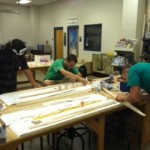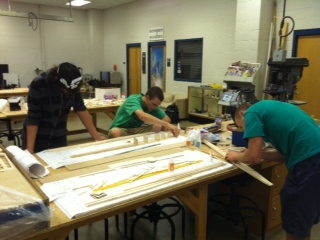
Ever heard the saying: “It’s not rocket science?” In Mr. Kelley’s Aerospace class, it actually is.
Michael Kelley is a part-time pilot and is happy to teach his favorite subject. When asked if he thinks if his class would be defined as “cool,” Kelley responded, “Yes, why not. I get to deal with airplanes all day long. What other class gets to do that?”
There are multiple levels of aerospace, each class becoming more specified and more difficult.
In Aerospace 1 you have the chance to fly on the simulators, build model rockets and take a field trip to RDU airport.
Ben Cox, sophomore and previous Aerospace 1 student, said, “It was an interesting class, we fly simulators and talk about airplanes, aerodynamics, rockets, and we build paper airplanes and wooden planes too. It was interesting, but it wasn’t easy.”
Aerospace 2 is “not for someone who doesn’t like it [aerospace]. It can be a rewarding class; you have to work for it though,” said Paul Hughes, junior. A difficult class, yes, but Hughes said, “I really like the way Mr. Kelley teaches it. There are lots of fun projects like building two stage rockets, building a wooden glider with a two foot wingspan, and simulator flights that lasted for longer than an hour.”
Aerospace 3 is more specified. They spend more time on projects and their studies are very intensive. “It is a pretty good class,” said Jason Rohn. “We built a Paragon glider, a model plane with a 10 foot wingspan. The class is a lot of work, but it pays off in the end.”
Aerospace has quite a payoff. While other classes involve memorizing facts, Aerospace incorporates critical thinking, cooperation and problem solving. Students manipulate model aircraft to make them fly further or longer.
What makes this class cool is that it teaches students to think on their own rather than simply memorize facts.
Students come out of Aerospace I with a good foundation of the aviation industry. Aerospaces II and III focus more on the problem solving aspects of aviation.
“I’m not trying to make pilots here, but this class is definitely a good start to getting into the aerospace field,” said Kelley.
It is, in fact, an incredibly good start; past aerospace students have made it into the the Air Force and Navy. Kelley even taught four students who now work for NASA.
In the end, this class teaches more than just aviation, it provides students with the skills needed to solve problems in other technological fields, whatever career path they select.

Leave a Reply